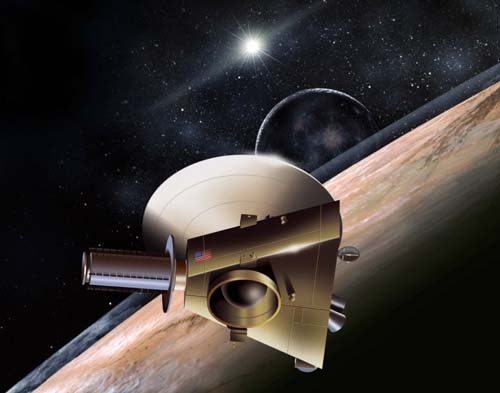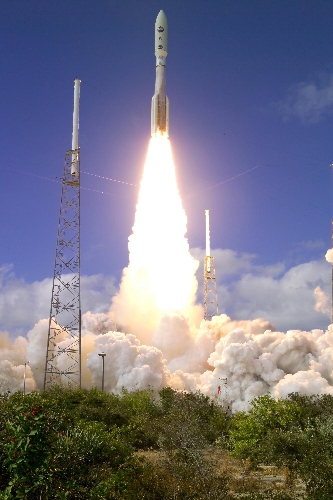Pluto mission excites Nevada scientists
As you read these words, a robotic spacecraft no bigger than a Volkswagen Beetle is racing toward Pluto at about 13 times the speed of a rifle bullet.
The New Horizons probe has traveled more than 2 billion miles since it left Earth in January 2006, and it still has almost a billion miles to go before it reaches its destination in 2015.
Giles Marion is eager to see what the spacecraft discovers when it finally gets there.
Marion is a geochemist with the Desert Research Institute in Reno, where he specializes in the study of chemical processes at extremely cold temperatures. He has even created a computer model called FREZCHEM that other researchers now use to predict subzero geochemical reactions and study such things as the possibility of life on other planets.
But that's not Marion's only connection to Pluto.
Back in 2006, he joined a few hundred other researchers in a small act of rebellion against the International Astronomical Union, the group that shocked the scientific world and elementary school children everywhere by stripping poor, put-upon Pluto of its planetary status.
Shortly after IAU's controversial vote in Prague, a petition was circulated opposing the decision.
Marion and the other ninth-planet partisans who signed it said they did not agree with the union's new definition of "planet" and had no intention of using it.
The rare public fight among planetary scientists and astronomers flared briefly and then faded, but IAU's reclassification remains in effect. Officially, our solar system is home to eight full-fledged planets and a growing new class of dwarf objects -- or plutoids as they are now adorably known.
The new definition was prompted by the discovery of other Pluto-like objects beyond Neptune, in a relatively crowded debris field known as the Kuiper Belt, including at least one body more massive than the erstwhile ninth planet.
Pluto has always been considered an oddball. For one thing, it's tiny -- just two-thirds the size of Earth's moon and less than half the size of Mercury, now considered the smallest planet. And it has a wildly different orbital pattern than the rest of the solar system, one that actually brings it closer to the sun than Neptune at certain times.
Marion said he didn't really have a dog in the fight over Pluto, but he decided to sign the petition out of solidarity with his fellow researchers.
"It's not something I'm losing sleep over," he said.
UNLV astrophysicist George Rhee never got directly involved in the great planetary debate, but he certainly followed it. After all, it's not every day that a broad scientific term gets redefined in such high-profile and contentious fashion.
"I think you see this sort of public row in climate change," Rhee said. "In astronomy, the controversies don't make it out into public that often. It is kind of unusual."
It's also just the sort of dispute that is bound to occur in an unprecedented age of discovery such as the one in which we're living, he said.
When Rhee started teaching at the University of Nevada, Las Vegas, the only known solar system was our own.
"Now we know of thousands of candidate solar systems," he said. "That's an amazing change in the span of 16 years or whatever it's been."
Rhee said some sort of new definition was needed, if only to give a name to the 5,000 other bodies just like Pluto that might one day be discovered beyond the orbit of Neptune. To call them all planets "gets a bit weird," he said.
Rhee tends to focus on broader, extra-galactic questions -- things like the origin of stars and the universe -- but he too has a direct link to Pluto.
As a professor at New Mexico State University in the early 1990s, he once met Clyde Tombaugh, the man who discovered the "ninth" planet.
By then, Rhee said, Tombaugh was a retired astronomy professor in his 80s, but in 1930 he was a tireless 23-year-old researcher at Lowell Observatory in Flagstaff, Ariz., who spent untold hours staring at tiny specks on photographic plates of the night sky.
"It was a remarkable feat of perseverance," Rhee said of Tombaugh's discovery, which was made without the aide of modern telescopes or computers. "He seemed like a nice man."
Tombaugh died in 1997 at age 90. His ashes are now on their way to Pluto on board New Horizons.
The NASA mission reached a milestone last month, when the spacecraft came within 982 million miles of Pluto, the closest any man-made vehicle has ever come to the icy world.
That record should continue to shrink by the second until July 2015, when New Horizons is expected to buzz past Pluto at a distance of about 7,800 miles on its way to unveil more mysteries of the Kuiper Belt.
Ultimately, Rhee said it doesn't really matter whether the general public -- or even the entire scientific community -- comes to embrace Pluto's new classification. If people want to keep thinking of it as a planet, so be it, he said.
"It's not going to change the world what we call it," Rhee said.
Marion feels much the same way, regardless of what petitions he might have signed.
"There's a mission going on right now on its way to Pluto, and it doesn't matter whether it's a planet or not," he said. "I'll be very interested in what they find out there."
Contact reporter Henry Brean at hbrean@reviewjournal.com or 702-383-0350.


















